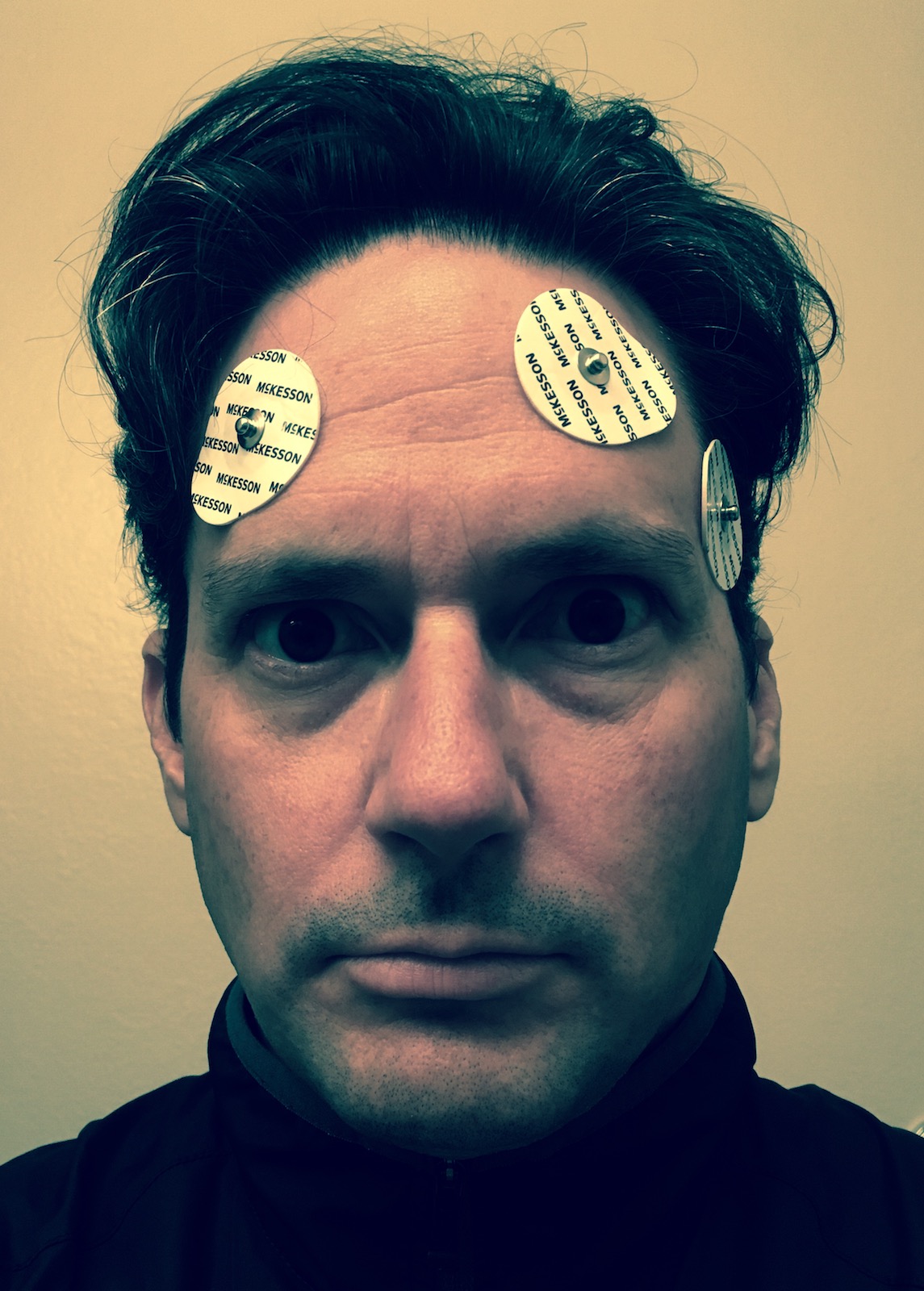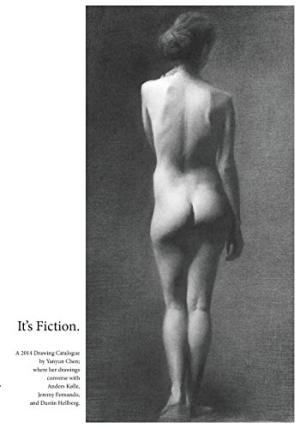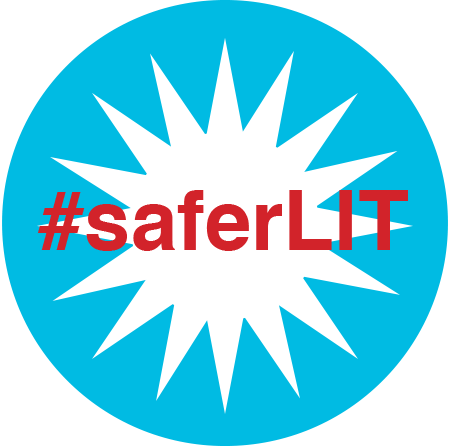ISSN: 1941-4137
POETRY THAT ENACTS THE ARTISTIC AND CREATIVE PURITY OF GLASS
POETRY THAT ENACTS THE ARTISTIC AND CREATIVE PURITY OF GLASS

James Batcho is a professor, writer and lecturer, currently teaching cinema at United International College in Zhuhai, China. He has written for Media Culture & Society, Journal of Sonic Studies, The New Soundtrack and Atropos Press. His second book, Terrence Malick's Unseeing Cinema, will be released in 2018.
November 7, 2017
Edited by Stephanie Kaylor
Edited by Stephanie Kaylor
Review of It's Fiction by Yanyun Chen
 It's Fiction
by Yanyun Chen
Delere Press, 2014
The photograph has its frame; the drawing, its canvas. The frame makes the image through its reveal. The canvas can only reveal through what it makes. The first begins with life, while the second begins blank, empty, or so it is often said, in whiteness. The blank canvas. But in Yanyun Chen's book It's Fiction, the fictions she makes begin in the dark, in blindness. From blindness comes the chance for another seeing, the making of a fiction — a new life. Such possible relations are revealed through both her images and the words her viewers write about them. Chen's book, as a collective work, is a series of Meditations — in one sense of the word, a mediation on these themes, but also as meditations themselves, offering a timelessness within time. Her collection of works here span a variety of moods and exposures, while the subjects she forms are arranged with a precision meant to be contained within the canvas, frontally and in stasis. She is complemented by three writers "in conversation" with her work: Anders Kølle, Jeremy Fernando, and Dustin Hellberg. As a whole, it feels like such a gathering, as all four participants come from The European Graduate School and are informed by complementary readings in contemporary European philosophy.
Chen's "matter," the material of her art, is on the one hand this canvas that gives sight. The other is what she presses into this whiteness, the blackness of charcoal. At this level, the object — the referent, one might say, although that does not apply here — functions as an idea. But it is the line, the stroke, the blur that makes here and not there, now and then again. Its unthought decision to stop or to continue contours its making, the making of itself. This is Chen's immanence. Not the object coming through, nor black on white, but darkness welcoming the emergence of light, a blindness given its own sight, a reveal. So one can appreciate and admire the stroke and pressure of the craft — black on white that gifts light to darkness — but what we see is emergence, the becoming of art as itself. It is a triadic immanence if one chooses to think it: object, media, drawing. But to lose oneself in the work is to see an expression both independent and inseparable from the world of things. The reality of things and the expression of making gives way to the expression made. As Gilles Deleuze suggests, immanence without the necessity to refer to, immanence itself. A kind of music without sound. Blindness that sees, silence that listens, anew.
And in some way, not the same way, writing does this as well. Fernando writes that he has already written, before writing, when he was within his encounter with Chen's encounter. His muse here — is he listening as he sees, as he is already writing? — is not only her but Hélène Cixous, Jacques Derrida and others. Fernando's is the longest written meditation here, opening to remembrance and its forgetting, blindness and its seeing, echoes and their sounds. As with Chen's drawings, these are not such black and white events and rather are given life thorough each other. Here is the possibility of poetry, of giving life to such resonances as themselves, a possibility born from knowing only that we can never be so sure of either/or, living as we do in the contour that marks not a divide but a duration. Here lies a timeless moment of the eternal as Plotinus, Kierkegaard, Borges might say, albeit under different circumstances.
Kølle opens the writings by setting the darkness of invisibility in concert with the whiteness of surface, the unseeing and the canvas as the co-relational ground without form. It is not the object that makes image, for there is no prior thing; the only prior, the life, the locus of becoming, is Chen, whose lines give shape to these two extremes of potentiality, back and white, which have no shape, no existence of their own. What becomes is drawing: the work, the making of a fiction.
With a photograph the referent is real. The fiction comes in the beholder of the photograph then imagining what came before, what became after. What led to this earthly point, this piercing moment, and what continued in this life after this occurrence that gave cause to capture it? Yet drawing has a curious way of completing its own fiction. What we may name as the cup, the figure, the flower, the drawing, as Kølle says, becomes itself. It has somehow completed its process and its life can only be here, naked, revealing only itself. Drawing totalizes its own time, time as immanence to nothing but itself. Or as Hellberg writes in a poem titled "Y," it becomes an aurora to itself, "an intonation self-sounded…" This is not a closure. A living dance of imagery, signs and memory is conjured in this viewing. In this act the truth of fiction is made from this time, these writers' time, the time of their viewing. As one gives attention to this time, one unsees more than one sees, ushering the forces of invention and imagination to make fiction from what is made as fiction. In the coexistent duration that both takes and gives time, one creates imagery.
To live within such coexistent durations is to live in states of recollection and repetition. This, one might say, is the true matter of any artist or author. Such states of repetition reopen to blindness as a return to what has been lived so that new life may find expression. Chen's charcoal expressions are variations in repetition and the writing reflects this as well. Fernando, Kølle, Hellberg each writes himself again, whomever that may be. These cycles of drawing, viewing and writing neither begin nor end. They have little by way of closures and completeness; rather they are always in the midst of repetition. As so many philosophers have suggested, going at least as far back as Aristotle: the story begins in the middle. This is the work of immanence, this expression that is already being made in the making. Immanence is the work.
Yet there is a distinction to be made within the otherwise cohesive character of the book as a whole. And one may wonder if it is no accident that all the writers are men. For what is to be seen in Chen's drawings stands forth to be seen. Little is suggested outside the canvas. It is the writing, the reading, that resonates her, dancing outside the borders, but whose frequencies fold back into the image, giving timbre to the image, dare I say nurturing the image. The strength of her melody is harmonized by the writing that feels its way through this outside that folds within, giving a transcendental quality to her immanence, an inclusive and continuing resonance. Taken together, one might even say that there is a gesture toward new possibilities in feminism to be found in a collective work such as this. In an era when so many statements and images come from a place of having already decided, already closed the frame, one wishes there were more gatherings such as these.
Visit Yanyun Chen's Website
Visit Delere Press' Website
It's Fiction
by Yanyun Chen
Delere Press, 2014
The photograph has its frame; the drawing, its canvas. The frame makes the image through its reveal. The canvas can only reveal through what it makes. The first begins with life, while the second begins blank, empty, or so it is often said, in whiteness. The blank canvas. But in Yanyun Chen's book It's Fiction, the fictions she makes begin in the dark, in blindness. From blindness comes the chance for another seeing, the making of a fiction — a new life. Such possible relations are revealed through both her images and the words her viewers write about them. Chen's book, as a collective work, is a series of Meditations — in one sense of the word, a mediation on these themes, but also as meditations themselves, offering a timelessness within time. Her collection of works here span a variety of moods and exposures, while the subjects she forms are arranged with a precision meant to be contained within the canvas, frontally and in stasis. She is complemented by three writers "in conversation" with her work: Anders Kølle, Jeremy Fernando, and Dustin Hellberg. As a whole, it feels like such a gathering, as all four participants come from The European Graduate School and are informed by complementary readings in contemporary European philosophy.
Chen's "matter," the material of her art, is on the one hand this canvas that gives sight. The other is what she presses into this whiteness, the blackness of charcoal. At this level, the object — the referent, one might say, although that does not apply here — functions as an idea. But it is the line, the stroke, the blur that makes here and not there, now and then again. Its unthought decision to stop or to continue contours its making, the making of itself. This is Chen's immanence. Not the object coming through, nor black on white, but darkness welcoming the emergence of light, a blindness given its own sight, a reveal. So one can appreciate and admire the stroke and pressure of the craft — black on white that gifts light to darkness — but what we see is emergence, the becoming of art as itself. It is a triadic immanence if one chooses to think it: object, media, drawing. But to lose oneself in the work is to see an expression both independent and inseparable from the world of things. The reality of things and the expression of making gives way to the expression made. As Gilles Deleuze suggests, immanence without the necessity to refer to, immanence itself. A kind of music without sound. Blindness that sees, silence that listens, anew.
And in some way, not the same way, writing does this as well. Fernando writes that he has already written, before writing, when he was within his encounter with Chen's encounter. His muse here — is he listening as he sees, as he is already writing? — is not only her but Hélène Cixous, Jacques Derrida and others. Fernando's is the longest written meditation here, opening to remembrance and its forgetting, blindness and its seeing, echoes and their sounds. As with Chen's drawings, these are not such black and white events and rather are given life thorough each other. Here is the possibility of poetry, of giving life to such resonances as themselves, a possibility born from knowing only that we can never be so sure of either/or, living as we do in the contour that marks not a divide but a duration. Here lies a timeless moment of the eternal as Plotinus, Kierkegaard, Borges might say, albeit under different circumstances.
Kølle opens the writings by setting the darkness of invisibility in concert with the whiteness of surface, the unseeing and the canvas as the co-relational ground without form. It is not the object that makes image, for there is no prior thing; the only prior, the life, the locus of becoming, is Chen, whose lines give shape to these two extremes of potentiality, back and white, which have no shape, no existence of their own. What becomes is drawing: the work, the making of a fiction.
With a photograph the referent is real. The fiction comes in the beholder of the photograph then imagining what came before, what became after. What led to this earthly point, this piercing moment, and what continued in this life after this occurrence that gave cause to capture it? Yet drawing has a curious way of completing its own fiction. What we may name as the cup, the figure, the flower, the drawing, as Kølle says, becomes itself. It has somehow completed its process and its life can only be here, naked, revealing only itself. Drawing totalizes its own time, time as immanence to nothing but itself. Or as Hellberg writes in a poem titled "Y," it becomes an aurora to itself, "an intonation self-sounded…" This is not a closure. A living dance of imagery, signs and memory is conjured in this viewing. In this act the truth of fiction is made from this time, these writers' time, the time of their viewing. As one gives attention to this time, one unsees more than one sees, ushering the forces of invention and imagination to make fiction from what is made as fiction. In the coexistent duration that both takes and gives time, one creates imagery.
To live within such coexistent durations is to live in states of recollection and repetition. This, one might say, is the true matter of any artist or author. Such states of repetition reopen to blindness as a return to what has been lived so that new life may find expression. Chen's charcoal expressions are variations in repetition and the writing reflects this as well. Fernando, Kølle, Hellberg each writes himself again, whomever that may be. These cycles of drawing, viewing and writing neither begin nor end. They have little by way of closures and completeness; rather they are always in the midst of repetition. As so many philosophers have suggested, going at least as far back as Aristotle: the story begins in the middle. This is the work of immanence, this expression that is already being made in the making. Immanence is the work.
Yet there is a distinction to be made within the otherwise cohesive character of the book as a whole. And one may wonder if it is no accident that all the writers are men. For what is to be seen in Chen's drawings stands forth to be seen. Little is suggested outside the canvas. It is the writing, the reading, that resonates her, dancing outside the borders, but whose frequencies fold back into the image, giving timbre to the image, dare I say nurturing the image. The strength of her melody is harmonized by the writing that feels its way through this outside that folds within, giving a transcendental quality to her immanence, an inclusive and continuing resonance. Taken together, one might even say that there is a gesture toward new possibilities in feminism to be found in a collective work such as this. In an era when so many statements and images come from a place of having already decided, already closed the frame, one wishes there were more gatherings such as these.
Visit Yanyun Chen's Website
Visit Delere Press' Website
Glass: A Journal of Poetry is published monthly by Glass Poetry Press.
All contents © the author.
All contents © the author.





